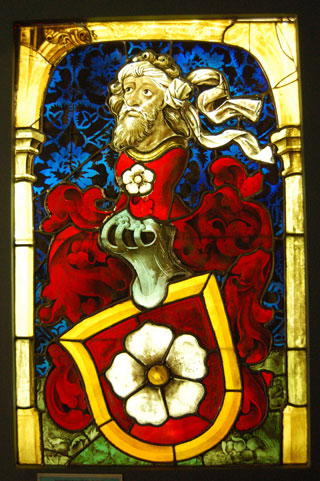Human Flower Project
Monday, September 25, 2006
Cinquefoil: I’ve Got a Secret
A white rose is still mysteriously fresh after five centuries.
 Rose (cinquefoil)
Rose (cinquefoil)
w/barbed vert, seeded gules
Image: The Heraldic Primer
At the Musee National du Moyen Age – what English speakers in Paris call “The Cluny Museum” – flowers bloom by the thousands, most of them five hundred years old. In tapestry, stone, gold, and now in the museum’s surrounding gardens, human flower projects endure, though their meanings mostly elude us.
One of the most stunning is a panel of stained glass made around 1467 in the workshop of master glazier Peter Hemmel of Strasbourg. It’s displayed in a dark room, backlit, the better to savor its color and detail. At the risk of sounding like a rube, we thought Sainte Chapelle – St. Louis’s giant jewel-box on the Ile de la Cite – was a squandering of splendor. Its stained glass miracles, too far off even for adolescent eyes to make out, dissolved into a huge, heavy kaleidoscope. (Being a secularist many centuries after the fact, perhaps we miss the point, though….)
In any case it was thrilling to see the art of Hemmel’s atelier up close. This piece, so we learned, shows the Mullenheim family coat-of-arms. We haven’t been able to discover much about the Mullenheims, just that they were powerful in Alsace in the 14-15th centuries. One site says that they took over the Ortenbourg Castle (presumably that took arm twisting) in 1314 and hung onto the place until 1469, just after this stained glass tribute was made. They reclaimed the castle in 1475 but by 1563 had abandoned it to robbers.
 Glass panel by the Atelier of Peter Hemmel, c. 1467
Glass panel by the Atelier of Peter Hemmel, c. 1467
at the Musee National du Moyen Age, Paris
Photo: Bill Bishop
The white flower so prominent here, on both the shield and the figure’s breast, is a stylized, wild rose, usually called a cinquefoil. (Cinquefoil also refers to a species of strawberry flower, likewise with five-petals.) Along with the fleur de lis, thistle and trefoil (shamrock), it is the most prevalent flower of heraldry. But what does the cinquefoil mean? Medieval artists were geniuses of ornament yet their imagery was more than decorative. Hemmel’s workshop could produce only about 15 glass panels per year. So one can be sure that every form on every piece, as well as being beautiful, bore a message.
One clue, from a site all about the first families of Alsace, says, “the rose was often used in Germanic courts of the middle ages as a symbol of discretion, and it was not therefore surprising that the magistrates of the town chose it as their ‘sceau secret’” (a seal marking certain documents “top secret”).
The association of roses and secrecy goes back to classical mythology, Aphrodite giving the rose to her son Eros, god of Love. “Eros gave the rose to Harpocrates, the God of silence, to induce him not to gossip about his Mother’s indiscretions. Thus the rose became the emblem of silence and secrecy. In the middle ages a rose was suspended from the ceiling of a council chamber, pledging all present to secrecy, or sub Rosa, ‘under the Rose.’” (We had thought this was a Roman custom, as perhaps it had been.)
So can we take Herr Mullenheim, emblazoned with the cinquefoil, for a tight-lipped judge or a CIA agent of the 15th century (as well as the edgy inheritor of a stolen castle)? For now, the secret appears to be safe with Peter Hemmel and his 15th century associates.




